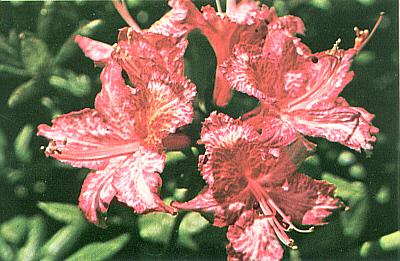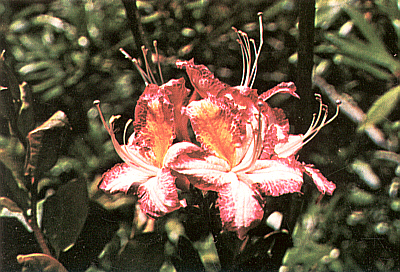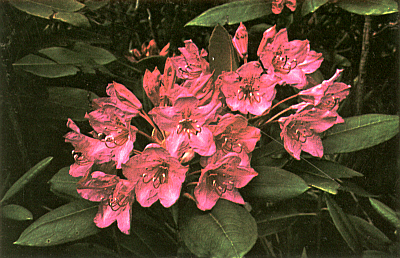A Trip To Remember
Britt M. Smith, Kent, Washington
The blooming season of 1971 is the sixth during which Dr. Frank Mossman has generously shared with me his quest for variations of
Rhododendron occidentale
. Each year, even each trip, we wonder what new attractive variation we will find. We wonder of the limits of variations of the species and how many species there would be if each species were allotted that same magnitude of variation. At times I have wondered if there could be enough variation to make further searching worthwhile, but Frank spurs me on, and we always find some new specimen which makes the search not just worthwhile, but rewarding in an exciting way. We have found
R. occidentale
which is white, yellow, or pink - some so deeply pink that the color is probably best described as being "dirty" pink looking. We have talked often of the pleasure we would find in a truly red
R. occidentale
. The quest for red has been long in our minds, along with the realization that the chance of finding one is very remote.
On our trip to "occidentale land" during the Memorial Day weekend of 1971, we had spent one arduous day during which we had catalogued one plant with large, deep pink flowers, and it was, at the time of our story, along in the afternoon of the second day. We were not experiencing our usual success, so, for diversion, we were visiting the spots where plants had been previously removed to determine if those plants are growing again from remaining root fragments. Frank was leading the way, breaking trail through tall grass, bracken ferns, and small
R. occidentale
plants. A flash of red caught my eye! Fortunately I was wearing heavy leather gloves as is our practice, because I plowed right into twenty or so feet of tangled brush, weeds, grass and ferns through which I had seen the flash of red. You know what was on my mind! Before half the distance had been covered, I literally went out of my mind for a moment. In a few seconds I arrived back on earth after somehow breaking a trail through a tangle which we would usually not attempt to penetrate, and was standing with Frank beside me, each of us high with the excitement of finding what is probably the most spectacular
R. occidentale
we have ever seen. Words cannot describe it adequately, so color pictures are provided in order that the reader can literally see the flowers as we saw them.

|

|
| R. occidentale , S. M. No. 502, "as it opens." | R. occidentale , S. M. No. 502, "After a few days." |
| Photos by Britt M. Smith | |
The bush is probably seven feet tall and grows in three small clumps. It is slender, since it is crowded upward by the surrounding plant life. The florets, which are not large (two and one-half inches in diameter), are nearly red when they open and are rather spotted in appearance. The centers of the lobes soon fade to white, but the very rich pink coloring of the borders persists to provide a striking picotee. Trusses contain approximately sixteen florets.
We spent two hours taking pictures, taking pollen, taking growth away from around the plant, taking cuttings, and taking two or three "layers". We applied pollen, marked the plant location and oriented ourselves - only to find that we were within thirty feet of a trail which we had traveled many times. There could be great discussion about the necessity of being in exactly the right spot at the right hour of the right day of the right year, but it seems best to go on with the story of discovery.
Late in the afternoon of the next day we were hurrying toward home, and we must hurry because we drive 1,500 miles and spend most of three days "in the occidentale patches", all on a three day trip. As we were approaching Langlois, Oregon, my thoughts focused on a spot north of that town where we have seen some attractive variations of
R. macrophyllum
. In my collection is white
R. macrophyllum
, and a very attractive pink
R. macrophyllum
with brown spotting on the upper lobe and slight indumentum on the leaves. Rumors of lavender
R. macrophyllum
on the Olympic Peninsula have been heard, but my quest has been for a red
R. macrophyllum
in addition to the red
R. occidentale
previously mentioned. Frank has not been as interested in
R. macrophyllum
as I have, so I dismissed the whole affair from my mind. We had passed through Langlois and my mind was on other things, when suddenly Frank applied brakes and said, "See that red macrophyllum! All right, damn it, you win. I'm hooked!" We were at the area where the attractive
R. macrophyllum
variations grow. The plant which had caught Frank's eye was blooming profusely with the most nearly red macrophyllum florets either of us had ever seen. Pictures were taken, and a section of root was taken. Cuttings were too soft. A picture is included so that readers may see the color which attracted us.

|
| R. macrophyllum , "The most nearly red we have seen." |
Now we wonder even more about the variation of R. occidentale . We wonder about the variation of R. macrophyllum also, and further, we wonder about the variation of other species and what specimens are still growing somewhere, displaying flowers of greater beauty that we have imagined.